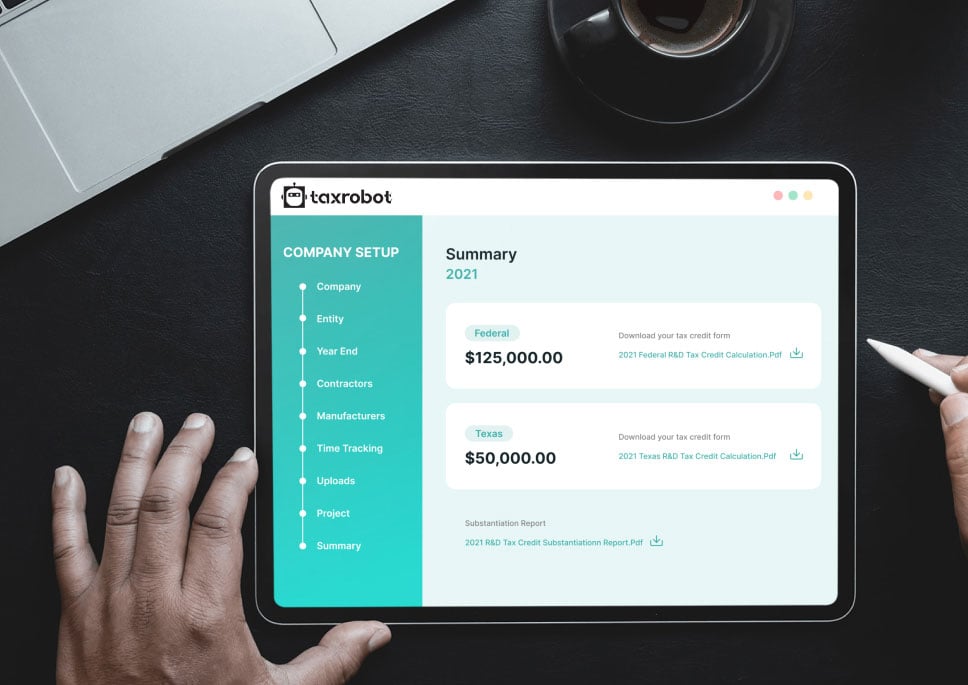Kentucky R&D Credit
Let TaxRobot help you maximize your Kentucky R&D credit savings.
Maximize your State Credits today!
Put the R&D tax credit process on autopilot.
Trusted By:








Kentucky R&D Credit
Discover your eligibility for Kentucky R&D tax credits and supercharge your enterprise.
Are There R&D Tax Credits in Kentucky?
Yes, there are R&D tax credits available for businesses doing work within Kentucky. The available credit is designed to encourage businesses to invest in constructing facilities dedicated to research and development. This exists alongside the Kentucky Economic Development Finance Authority, which also helps promote business within the state by providing incentives.
This makes this tax credit different from others. The exact nature of the credits is different from many other states and even the federal system. This makes paying attention to details surrounding the Kentucky R&D credit incredibly important.
Qualified Research Facility Tax Credit
Tax credits in other states generally revolve around the amount of money spent on qualified research expenses that relate to research and development. For example, the Texas R&D credit functions like this. However, Kentucky does things differently. Instead of focusing on this, the Kentucky credit focuses on the construction of research facilities.
This forms the basis of the Qualified Research Facility Tax Credit. The credit equals 5% of the cost of constructing, remodeling, equipping, or expanding research facilities designated for qualified research. These facilities have to be located within Kentucky to be applicable for this tax credit.
The definition for this qualified research is the same as the definition used for the federal government’s R&D tax credit. This can be found when looking at qualified expenses for the federal credit. Only facilities housing this type of research apply for this tax credit.
The Kentucky tax credit is a nonrefundable credit. It can be carried forward for ten years.
Federal R&D Tax Credit
Kentucky businesses aren’t just limited to the Kentucky R&D tax credit. They can also apply for the federal R&D tax credit.
This is a more straightforward and standard credit based on the amount of R&D spending a company has. It is calculated using the amount a company spends on qualified research expenses. The tax credit is 20% of the difference between this amount and the base amount.
Applying for this requires submitting the relevant information alongside a tax return. The IRS’s website even provides a fact sheet to help with this process. However, the process can still be complicated and is prone to errors. Paying close attention is necessary to prevent errors from ruining an application.
How to Claim the Kentucky R&D Tax Credit
The process of claiming the Kentucky R&D tax credit revolves around Schedule QR. This form needs to be filled out with the relevant information relating to expenses for the construction of research facilities. This should be submitted alongside the income tax return claiming the credit.
When applying for carryforwards, this form is also needed. Copies of the form must be attached to the income tax return claiming the carryforward.
Get the Most Out of Your R&D with TaxRobot
Since Kentucky uses a different process than most R&D tax credits, it can be a little difficult for some people to work with. Plus, the fact that it is entirely different from the federal R&D tax credit means that more work, time, and research will go into applying for both. This can be a drain on resources that could be better spent elsewhere.
TaxRobot has the capability to help with this. We offer tax credit consulting services that will give a precise picture of what credits are available to you and how you can claim them. We can then process your application using our advanced tax software to ensure that you get the most from any credits you are eligible for. By the end of the process, we’ll have saved you time, prevented frustration, and allowed you to get the most from these tax credit programs.
See How Much You Could Save
Try our calculator and see how much you could save with TaxRobot and the R&D credit.
Take a sneak peak

- Limited Time Offer
- Simple Onboarding
- Easy to Use
R&D Tax Credits FAQs
The four-part test as outlined in the Internal Revenue Code is used to determine qualified R&D activity.
The Four-Part Test
1). New Or Improved Business Component
Creation of a new product, process, formula, invention, software, or technique; or improving the performance, functionality, quality, or reliability of existing business component.
- Construction of new buildings or renovation of existing buildings
- Invention of a software application
- Manufacturing of a new product or the improvement of the production process for an existing product
- Creation of design documentation
2). Technological In Nature
The activity fundamentally relies on principles of the physical or biological sciences, engineering, or computer science. A taxpayer does not need to obtain information that exceeds, expands or refines the common knowledge of skilled professionals in a particular field.
- Physics (relationship between mass, density and volume; loading as the
result of gravitational attraction) - Engineering (mechanical, electrical, civil, chemical)
- Computer science (theory of computation and design of computational systems)
3). Elimination Of Uncertainty
Uncertainty exists if the information available to the taxpayer does not establish the capability or method for developing or improving the business component, or the appropriate design of the business component.
- The capability of a manufacturer to create a part within the specified tolerances
- The appropriate method of overcoming unsuitable soil conditions during construction
- The appropriate software design to meet quality and volatility requirements
4). Process Of Experimentation
A process designed to evaluate one or more alternatives to achieve a result where the capability or method of achieving that result, or the appropriate design of that result, is uncertain as of the beginning of the taxpayer’s research activities.
- Systematic process of trial and error
- Evaluating alternative means and methods
- Computer modeling or simulation Prototyping Testing
The R&D tax credit is one of the most misunderstood tax incentives available. Considering the myriad of industries and activities that legally qualify for the credit, the term “research and development” is a misnomer. Additionally, the R&D tax credit requires specialized knowledge and technology to identify and calculate the incentive properly.
Companies of various industries are unaware that they are eligible to claim the R&D tax credit. Under the Internal Revenue Code’s definition of R&D, many common activities qualify. You can get tax benefits for industries including software, technology, architecture, engineering, construction, manufacturing, and more.
The R&D tax credit can be claimed for all open tax years. Generally, open tax years include the prior three tax years due to the statute of limitations period. In certain circumstances, the law allows businesses to claim the R&D tax credit for an extended period of time. It is common for companies to amend previous tax years to claim this benefit and reduce the maximum amount of tax liability.
Partnerships and S corporations must file this form to claim the credit. The credit will flow from the Form 6765, to the Schedule K-1, to the Form 3800 on the individual’s tax return. For individuals receiving this credit that have ownership interest in a partnership or S corporation, Form 6765 is not required on the individual return.
Individuals claiming this credit can report the credit directly on Form 3800, General Business Credit if their only source for the credit is a partnership, S corporation, estate, or trust. Otherwise, Form 6765 must be filed with the individual’s tax return (e.g. sole proprietorship).
For tax years prior to 2016, the credit can be used to reduce the taxpayer’s regular tax liability down to the tentative minimum tax. The credit cannot be used to offset alternative minimum tax. Beginning in tax year 2016, eligible small businesses have expanded utilization for the credit. For these eligible small businesses, the regular tax liability can offset alternative minimum tax using the “25/25” rule.
What our customers have to say
I highly recommend TaxRobot to anyone considering an R&D Tax Credit software to complete their analysis.

We decided to switch to TaxRobot… Best decision we’ve ever made. More affordable, and less complicated.

I couldn’t believe how easy it was! In under an hour, we saved enough money to hire a new employee.
